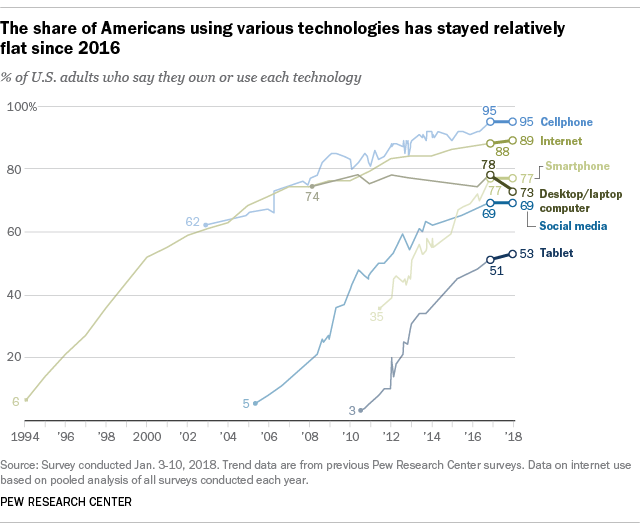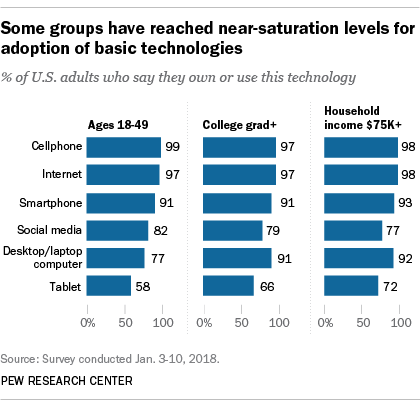Growth of Social Media Usage in Usa
The utilise of digital technology has had a long stretch of rapid growth in the United States, simply the share of Americans who go online, use social media or ain key devices has remained stable the by two years, according to a new analysis of Pew Research Middle data.

The shares of U.Southward. adults who say they utilize the cyberspace, apply social media, own a smartphone or own a tablet figurer are all nearly identical to the shares who said then in 2016. The share who say they have broadband internet service at home currently stands at 65% – nearly identical to the 67% who said this in a survey conducted in summer 2015. And when information technology comes to desktop or laptop ownership, there has actually been a small dip in the overall numbers over the final two years – from 78% in 2016 to 73% today.
 A contributing factor behind this slowing growth is that parts of the population have reached virtually-saturation levels of adoption of some technologies. Put simply, in some instances there simply aren't many non-users left. For example, 9-in-10 or more adults younger than fifty say they become online or ain a smartphone. And a similar share of those in higher-income households take laptops or desktops.
A contributing factor behind this slowing growth is that parts of the population have reached virtually-saturation levels of adoption of some technologies. Put simply, in some instances there simply aren't many non-users left. For example, 9-in-10 or more adults younger than fifty say they become online or ain a smartphone. And a similar share of those in higher-income households take laptops or desktops.
Still, there are noteworthy numbers of non-users of various technologies. Surveys conducted by the Heart over the years highlight how these non-adopters of various technologies often face substantial and multifaceted barriers.
In some cases, Americans who would similar to take advantage of new technologies are but unable to do then considering of financial restrictions. In a 2015 survey, 43% of non-broadband adopters cited cost (either the price of a computer, or the cost of the broadband subscription itself) as the principal reason they did not have broadband service at home. For other Americans, technology adoption may differ by where they live. A survey conducted earlier this year found that roughly six-in-x Americans living in rural areas say that admission to high speed internet is a problem in their local customs. That compares with 43% of those in urban areas and 36% living in suburbs.
In other instances, non-users say they practice not see the value of learning how to use new technologies. In a 2013 survey, the Center found that 34% of non-internet users did not become online because they had no involvement in doing so, or did not call back the net was relevant to their lives.
In addition, certain groups of Americans – most notably, older adults – confront their own unique challenges when it comes to using and adopting new technologies. In a 2015 survey, 34% of cyberspace users ages 65 and older said they had little to no confidence in their ability to apply electronic devices to perform online tasks, while 48% of older adults said the statement, "When I become a new electronic device, I commonly need someone else to set it up or testify me how to use it" describes them very well. And a substantial share of seniors reports they take chronic health condition, disability or other type of concrete limitation that might prevent them from fully utilizing a variety of devices.
While many long-standing measures of technology adoption accept steadied the by two years, the ways that people get connected and utilize digital platforms are constantly shifting and evolving. For instance, Pew Inquiry Center surveys accept shown that the number of people who are "smartphone-simply" internet users – meaning they ain a smartphone but exercise not have traditional abode broadband service – has grown from 12% in 2016 to twenty% this year.
And although the shares of Americans who utilise sure social media platforms have changed little in recent years, that has not been truthful with every site. The percent of adults using Instagram, for case, has grown from 28% in 2016 to 35% this year. And looking beyond the adult population, the social media environment of today's teenagers looks remarkably different than it did just a few years prior.
Meanwhile, new continued devices keep to emerge. Consumer surveys show that the use of smart TVs and habiliment devices has grown in recent years. Most one-half of Americans (46%) use digital voice assistants on smartphones or devices similar Amazon Echo, co-ordinate to a 2017 Pew Research Centre survey. A host of items collectively called "the Internet of Things" – ranging from household thermostats and security systems to "smart metropolis" transportation systems – are also coming on the marketplace.
Ultimately, the method for tracking sure adoption metrics may need to change. A canvassing of experts by the Center suggested that it might brand sense in the nigh future to terminate request people if they "utilise the internet" considering it will be so ubiquitous. Those experts predicted that the internet would go "like electricity" – almost invisible to users, even so more than deeply embedded in their lives.
Paul Hitlin is a sometime senior researcher focusing on net and technology research at Pew Inquiry Heart.
0 Response to "Growth of Social Media Usage in Usa"
Post a Comment